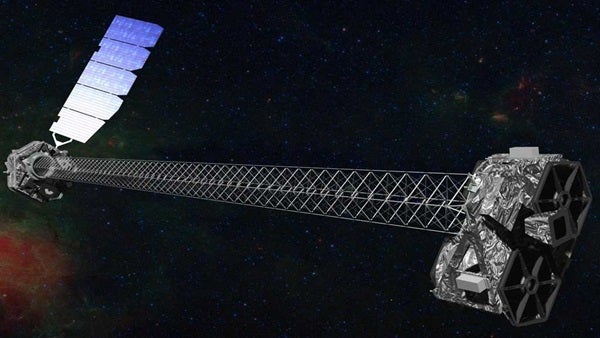For example, in early April, the blazar Markarian 421 had an episode of extreme activity, brightening by more than 50 times its typical level. Blazars are a special class of galaxies with accreting, or feeding, supermassive black holes at their centers. As the black holes feed, they light up, often ejecting jets of material. When the jets are pointing toward Earth, they are called blazars. By using telescopes sensitive to a range of energies to study how blazars vary, astrophysicists gain insight into black-hole feeding processes and the physical conditions near the black hole.
NuSTAR got lucky in the case of Markarian 421 because it was already observing the blazar at the time of its eruption simultaneously with other telescopes, including NASA’s Fermi and Swift satellites. The flare-up was the brightest ever observed for this object. In fact, it was so bright that NuSTAR and other telescopes changed their observing cadence to spend more time studying this galaxy. More on these findings will be available after the scientists have analyzed the data.
Just a few weeks after this event, toward the end of April, NASA’s Swift satellite noticed the region around the center of our Milky Way Galaxy had suddenly lit up. Flares lasting from a few minutes to three hours are not uncommon for the black hole in the center of the Milky Way, known as Sagittarius A*. In fact, NuSTAR observed such a flare last July. However, this new event had lasted tens of hours and got the whole high-energy community excited. NuSTAR was one of the first “on the scene,” observing the galactic center less than 50 hours after the initial Swift discovery. The NuSTAR findings revealed that the brightening was due to a type of neutron star called a magnetar, and not Sagittarius A* itself.
Yet another event popped up in the sky just a few days later, surprising astronomers. Swift found an extremely bright gamma-ray burst brighter than any event it had previously identified during its nearly 10 years in orbit. A gamma-ray burst is a huge release of energy from a distant galaxy thought to be triggered by the collapse of a massive star.
The astronomical community, including NuSTAR, quickly reacted to the blast. NuSTAR provided the first focused high-quality observations of a gamma-ray burst in high-energy X-rays.
Beginning in April, the NuSTAR spacecraft gained use of the Kongsberg Satellite Services’ Singapore tracking station for extra command uplinks and data downlinks. The spacecraft’s primary tracking coverage is provided by the Italian Space Agency and uses antennas located in Malindi, Kenya, while data uplinks are provided by NASA’s Tracking and Data Relay Satellite System (TDRSS) antennas. The back-up Singapore tracking station is helpful for periods when additional coverage is needed either due to high data-rate targets, such as bright objects, or when the Malindi antennas are unavailable. Additional coverage has also been provided by the Universal Space Network’s Hawaii antenna.










